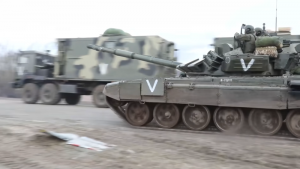What We Know About Depleted Uranium in Ukraine So Far?

All Global Research articles can be read in 51 languages by activating the Translate Website button below the author’s name.
To receive Global Research’s Daily Newsletter (selected articles), click here.
Click the share button above to email/forward this article to your friends and colleagues. Follow us on Instagram and Twitter and subscribe to our Telegram Channel. Feel free to repost and share widely Global Research articles.
***
In the recent months there have been multiple reports containing different information about the use of depleted uranium weapons in Ukraine. Due to the rapidly changing events and partly contradictory statements by different officials and media, it is hard to tell with certainty, what party of the conflict has already used weapons containing depleted uranium. Further problems arise from the fact, that DU issue is being further instrumentalized by different actors with e.g., Russian officials claiming that DU projectiles are nuclear weapons.
All of this led to uncertainty and to the necessity of updating our initial assessment.
ICBUW position on the issue is unchanged:
Regardless of which belligerent uses DU weapons, that use will result in widespread environmental and public health damage and is extremely problematic under international (humanitarian) law.
DU Use by Ukrainian Forces
According to our research, Ukraine does not have its own depleted uranium rounds. The United Kingdom has confirmed that Ukraine will receive depleted uranium shells, also the United States are planning to supply this type of weapons. Even more alarming are the news regarding the new contract awarded recently to Rocketdyne, which concerns the production of of DU rounds for M1 Abrams tanks. In light of this information, it seems that the US is not planning on phasing out DU ammunition after all.
Our position regarding this news has not changed either:
ICBUW regrets and condemns the decision of the British government to supply depleted uranium ammunition and urges the United States to refrain from supplying this type of ammunition to Ukraine and to rely on less toxic alternatives instead.
The topic of the supply of UK-made depleted uranium ammunition seems to be surrounded by fake news as well. One example is the report, that a warehouse storing British-supplied depleted uranium ammunition was destroyed in Khmelnitsky, claiming that radiation levels were rising in the aftermath of the strike. There is zero evidence, that the warehouse was a “depleted uranium storage facility”, the reports on radiation levels have also been dismissed as false by the IAEA.
DU Use by Russian Forces
Russia has a significant number of different DU rounds in its arsenals. There were multiple reports regarding the use of DU round by the Russian forces, however, we were unable to independently verify that this type of ammunition was already used in Ukraine. The initial reports by GICHD suggested that Russian-made depleted uranium ammunition was already found in Ukraine, but after further clarification, we received information, that the 3BM-32 round was included in the Explosive Ordnance Guide as a precautionary measure.
Due to secrecy, there is also some degree of uncertainty regarding the types of ammunitions in service with the Russian army, which have depleted uranium sabots. According to our research, 3BM-60 (“Svinets-2”) contains a depleted uranium-tungsten alloy penetrator. This information finds it’s confirmation in various sources, including Kommersant newspaper (see their recent article), TASS (see this report from 2018) and Zvezda (see this article). Based on this information, articles speaking of the “tungsten” core of the Svinets-2 appear to be misleading, i.e., telling half-truths regarding this type of ammunition.
Even though there is still no independent confirmation of the use of DU weapons by the Russian army, threats of DU use coming from Moscow are alarming. In June, Russian president Vladimir Putin stated that depleted uranium ammunition was not used so far in the conflict by Russia, but Russia reserves the right to use it if the Armed Forces of Ukraine use the US-/UK-supplied DU rounds. In this regard, ICBUW reminds, that the use of a weapon illegal under international law by one party of conflict does not justify the use of the same weapon by other belligerents. Such use only amplifies the adverse effects on the local population, contributing heavily to the environmental catastrophe.
We continue to follow reports of shipments or use of military equipment with depleted uranium components or DU ammunition and invite everyone with relevant information to share it with us.
*
Note to readers: Please click the share button above. Follow us on Instagram and Twitter and subscribe to our Telegram Channel. Feel free to repost and share widely Global Research articles.
Featured image: Russian T-80 Tank in Ukraine (Source: mil.ru)

